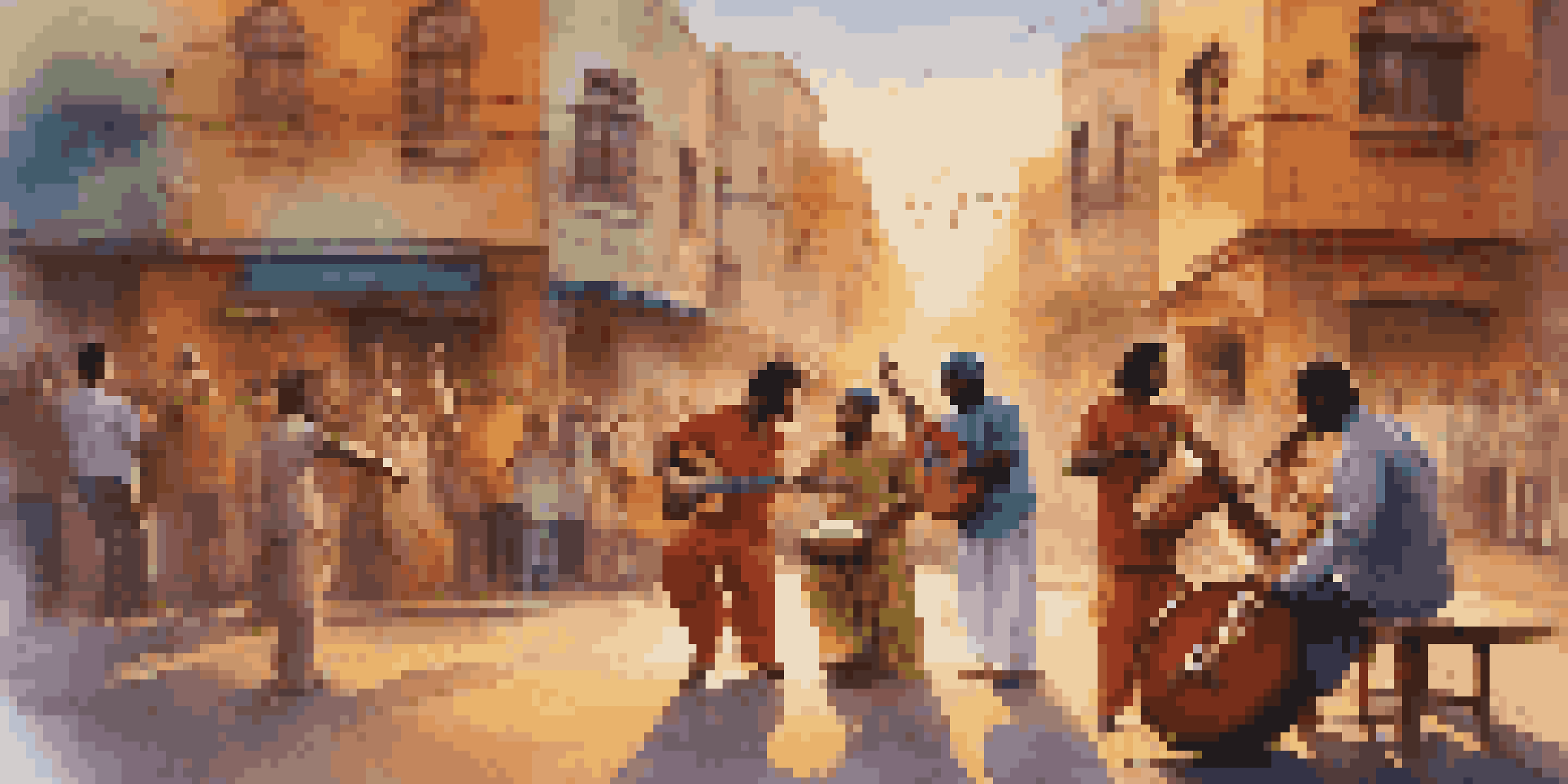World Music Fusion: Blending Traditions in Contemporary Sounds

What is World Music Fusion and Its Significance?
World music fusion is the beautiful blend of traditional music from various cultures with contemporary sounds. It creates a rich tapestry of auditory experiences, allowing listeners to enjoy diverse rhythms and melodies. This genre not only entertains but also fosters understanding and appreciation of different cultures.
Music is the universal language of mankind.
In today’s globalized world, music knows no boundaries. Artists draw inspiration from a multitude of sources, blending instruments and styles to create something entirely new. This fusion is essential as it keeps traditional music alive while also appealing to modern audiences who crave innovation.
For instance, think of the infectious beats of Afrobeat mixed with electronic sounds or the melodies of Indian classical music paired with jazz. Each collaboration opens doors to conversations about heritage and creativity, making world music fusion a vital part of our musical landscape.
Historical Roots of World Music Fusion
The roots of world music fusion can be traced back to ancient trade routes, where musicians exchanged ideas and instruments. As cultures interacted, they borrowed and transformed musical elements, resulting in the diverse sounds we hear today. This historical blending laid the groundwork for modern fusion genres.

In the 20th century, the rise of globalization accelerated this process. Artists began to explore outside their own cultural boundaries, leading to collaborations that highlighted the beauty of diversity. Genres like reggae, salsa, and bossa nova emerged, showcasing how traditional music could evolve and adapt.
Fusion Revives Cultural Heritage
World music fusion blends traditional and contemporary sounds, keeping cultural music alive while appealing to modern audiences.
These historical influences remind us that music has always been about connection. Just like spices in a great dish, each cultural sound adds depth and flavor, creating a unique auditory experience that resonates across generations.
Key Instruments Used in Music Fusion
In world music fusion, you’ll often find a delightful mix of traditional and contemporary instruments. For example, the sitar from India can be combined with the guitar, creating a unique sound that bridges East and West. This melding of instruments contributes significantly to the genre's rich texture.
The beauty of music is that it transcends all boundaries - cultural, geographical, and even emotional.
Percussion instruments also play a vital role in fusion music. The djembe from West Africa or the tabla from India can enhance the rhythmic complexity of modern tracks, making them irresistible to dance to. The synergy between these instruments creates a groove that is both familiar and fresh.
Additionally, electronic elements have become a staple in world music fusion. By incorporating synthesizers and digital effects, artists can take traditional sounds and elevate them to new heights, appealing to a broader audience while maintaining cultural authenticity.
Notable Artists in World Music Fusion
Several artists have made significant contributions to the world music fusion landscape. One standout is Yo-Yo Ma, whose Silkroad Ensemble brings together musicians from various cultures to create breathtaking compositions. His work exemplifies how collaboration can lead to profound musical experiences.
Another influential figure is Anoushka Shankar, who seamlessly fuses Indian classical music with contemporary genres. Her ability to blend traditions showcases the versatility of her art and invites listeners to explore a diverse soundscape. Through her music, she honors her heritage while embracing modern influences.
Technology Enhances Collaboration
Advancements in technology allow artists to experiment and connect globally, enriching the world music fusion genre.
And let’s not forget about the band Ozomatli, which infuses Latin rhythms with hip-hop and other genres. Their energetic performances and engaging sound reflect the vibrant culture of Los Angeles while also celebrating the global community, making them a prime example of world music fusion.
Cultural Impact of World Music Fusion
World music fusion has a profound cultural impact, as it encourages dialogue and understanding among diverse communities. By showcasing different musical traditions, artists can challenge stereotypes and promote inclusivity. This genre serves as a reminder that music is a universal language, capable of bridging cultural divides.
Fusion music also provides a platform for underrepresented voices in the music industry. Artists from various backgrounds can share their stories and experiences through their unique sound, gaining recognition in a global market. This visibility is crucial for preserving cultural heritage and inspiring future generations.
Moreover, the fusion of different musical styles can lead to a greater appreciation for world cultures. As listeners explore these sounds, they become more curious about the traditions and histories behind them, fostering a sense of respect and connection that transcends borders.
The Role of Technology in Music Fusion
Technology has played a pivotal role in the evolution of world music fusion. With the advent of digital recording and editing tools, artists can experiment and collaborate like never before. This accessibility allows for innovative combinations of sounds and styles, pushing the boundaries of what fusion music can be.
Social media platforms also serve as a powerful tool for artists to share their work and connect with audiences worldwide. Musicians can collaborate remotely, transcending geographical limitations and creating music that reflects a global perspective. This interconnectedness enriches the fusion genre and broadens its reach.
Fusion Promotes Cultural Understanding
By showcasing diverse musical traditions, world music fusion encourages dialogue and challenges stereotypes among communities.
Furthermore, technology allows listeners to explore diverse music from their own homes. Streaming services and music platforms provide access to a vast array of global sounds, encouraging fans to discover and appreciate the beauty of world music fusion. This democratization of music is vital for the genre’s growth.
Future of World Music Fusion
The future of world music fusion looks promising as artists continue to innovate and collaborate across cultural boundaries. As more musicians experiment with blending genres, we can expect to hear even more unique sounds that challenge our perceptions of music. This evolution will likely lead to the emergence of new sub-genres that reflect our increasingly interconnected world.
Moreover, the growing emphasis on diversity in the music industry will encourage more artists to explore their cultural roots and share their stories through fusion. This trend will not only enrich the genre but also ensure that a wide array of voices is heard in the global music conversation.

As we move forward, world music fusion will remain a powerful tool for cultural exchange and understanding. By celebrating our differences and commonalities through sound, we can create a more harmonious world that embraces the beauty of diversity.